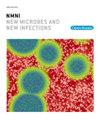Time series modelling and forecasting of Monkeypox outbreak trends Africa's in most affected countries
IF 2.9
Q2 INFECTIOUS DISEASES
引用次数: 0
Abstract
Background
The recent outbreak of Monkeypox (Mpox), particularly the clade 1b variant, have shifted the epidemiological landscape, making it a Public Health Emergency of International Concern. Africa remains a hotspot with significant ongoing outbreaks, necessitating a focused study on outbreak trends and forecasting to guide health interventions.
Methods
This study utilizes a comprehensive dataset from the four most affected African countries, covering weekly and cumulative Mpox cases from August 6, 2023, to August 18, 2024. Time series analysis techniques, including ARIMA models and Join Point Regression, were employed to forecast Mpox trends and analyse the annual percentage change in new cases.
Results
Descriptive statistics highlighted significant variability in Mpox cases across the studied regions with the mean cases in Africa at 72.55 and a high standard deviation of 60.885. Forecasting models suggest a continued increase in Mpox cases, with cumulative cases expected to reach 6922.95 by the 65th week (95 % CI: 6158.62 to 7687.27) and new cases projected at 45.93 (95 % CI: −88.17 to 180.04).
Conclusion
The study underscores the persistent nature of Mpox outbreaks in Africa and the critical need for continuous surveillance and adaptive public health strategies. The forecasts generated offer valuable insights into potential future trends, aiding in the allocation of resources and the implementation of targeted health interventions to curb the spread of the disease.
猴痘爆发趋势的时间序列建模和预测 非洲受影响最严重国家的猴痘爆发趋势
背景最近爆发的猴痘(Mpox)疫情,尤其是1b变种,改变了流行病学的格局,使其成为国际关注的公共卫生紧急事件。非洲仍是疫情热点地区,疫情持续严重,因此有必要对疫情趋势和预测进行重点研究,以指导卫生干预措施。 本研究利用了来自四个受影响最严重的非洲国家的综合数据集,涵盖了从 2023 年 8 月 6 日至 2024 年 8 月 18 日的每周和累计猴痘病例。研究采用了时间序列分析技术(包括 ARIMA 模型和连接点回归)来预测天花趋势,并分析新增病例的年度百分比变化。结果描述性统计突显了所研究地区天花病例的显著差异,非洲的平均病例数为 72.55 例,标准偏差高达 60.885 例。预测模型显示,麻痘病例将持续增加,预计到第 65 周,累计病例将达到 6922.95 例(95 % CI:6158.62 至 7687.27),新增病例预计为 45.93 例(95 % CI:-88.17 至 180.04)。预测结果为了解未来的潜在趋势提供了宝贵的信息,有助于分配资源和实施有针对性的卫生干预措施,以遏制疾病的传播。
本文章由计算机程序翻译,如有差异,请以英文原文为准。
求助全文
约1分钟内获得全文
求助全文
来源期刊

New Microbes and New Infections
Medicine-Infectious Diseases
CiteScore
10.00
自引率
2.50%
发文量
91
审稿时长
114 days
 求助内容:
求助内容: 应助结果提醒方式:
应助结果提醒方式:


